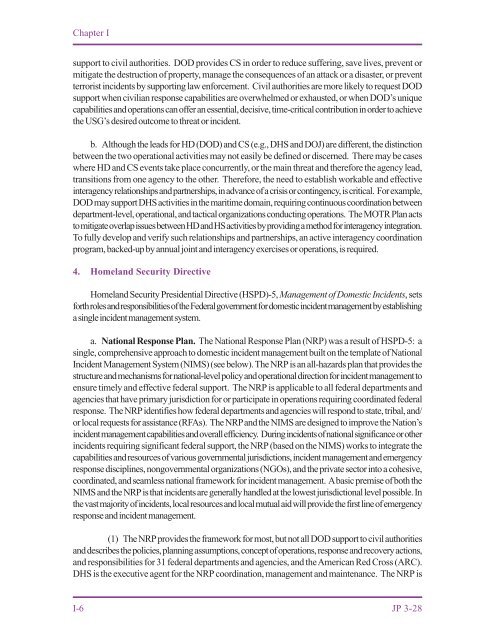JP 3-28, Civil Support - Federation of American Scientists
JP 3-28, Civil Support - Federation of American Scientists
JP 3-28, Civil Support - Federation of American Scientists
You also want an ePaper? Increase the reach of your titles
YUMPU automatically turns print PDFs into web optimized ePapers that Google loves.
Chapter I<br />
support to civil authorities. DOD provides CS in order to reduce suffering, save lives, prevent or<br />
mitigate the destruction <strong>of</strong> property, manage the consequences <strong>of</strong> an attack or a disaster, or prevent<br />
terrorist incidents by supporting law enforcement. <strong>Civil</strong> authorities are more likely to request DOD<br />
support when civilian response capabilities are overwhelmed or exhausted, or when DOD’s unique<br />
capabilities and operations can <strong>of</strong>fer an essential, decisive, time-critical contribution in order to achieve<br />
the USG’s desired outcome to threat or incident.<br />
b. Although the leads for HD (DOD) and CS (e.g., DHS and DOJ) are different, the distinction<br />
between the two operational activities may not easily be defined or discerned. There may be cases<br />
where HD and CS events take place concurrently, or the main threat and therefore the agency lead,<br />
transitions from one agency to the other. Therefore, the need to establish workable and effective<br />
interagency relationships and partnerships, in advance <strong>of</strong> a crisis or contingency, is critical. For example,<br />
DOD may support DHS activities in the maritime domain, requiring continuous coordination between<br />
department-level, operational, and tactical organizations conducting operations. The MOTR Plan acts<br />
to mitigate overlap issues between HD and HS activities by providing a method for interagency integration.<br />
To fully develop and verify such relationships and partnerships, an active interagency coordination<br />
program, backed-up by annual joint and interagency exercises or operations, is required.<br />
4. Homeland Security Directive<br />
Homeland Security Presidential Directive (HSPD)-5, Management <strong>of</strong> Domestic Incidents, sets<br />
forth roles and responsibilities <strong>of</strong> the Federal government for domestic incident management by establishing<br />
a single incident management system.<br />
a. National Response Plan. The National Response Plan (NRP) was a result <strong>of</strong> HSPD-5: a<br />
single, comprehensive approach to domestic incident management built on the template <strong>of</strong> National<br />
Incident Management System (NIMS) (see below). The NRP is an all-hazards plan that provides the<br />
structure and mechanisms for national-level policy and operational direction for incident management to<br />
ensure timely and effective federal support. The NRP is applicable to all federal departments and<br />
agencies that have primary jurisdiction for or participate in operations requiring coordinated federal<br />
response. The NRP identifies how federal departments and agencies will respond to state, tribal, and/<br />
or local requests for assistance (RFAs). The NRP and the NIMS are designed to improve the Nation’s<br />
incident management capabilities and overall efficiency. During incidents <strong>of</strong> national significance or other<br />
incidents requiring significant federal support, the NRP (based on the NIMS) works to integrate the<br />
capabilities and resources <strong>of</strong> various governmental jurisdictions, incident management and emergency<br />
response disciplines, nongovernmental organizations (NGOs), and the private sector into a cohesive,<br />
coordinated, and seamless national framework for incident management. A basic premise <strong>of</strong> both the<br />
NIMS and the NRP is that incidents are generally handled at the lowest jurisdictional level possible. In<br />
the vast majority <strong>of</strong> incidents, local resources and local mutual aid will provide the first line <strong>of</strong> emergency<br />
response and incident management.<br />
(1) The NRP provides the framework for most, but not all DOD support to civil authorities<br />
and describes the policies, planning assumptions, concept <strong>of</strong> operations, response and recovery actions,<br />
and responsibilities for 31 federal departments and agencies, and the <strong>American</strong> Red Cross (ARC).<br />
DHS is the executive agent for the NRP coordination, management and maintenance. The NRP is<br />
I-6<br />
<strong>JP</strong> 3-<strong>28</strong>

















